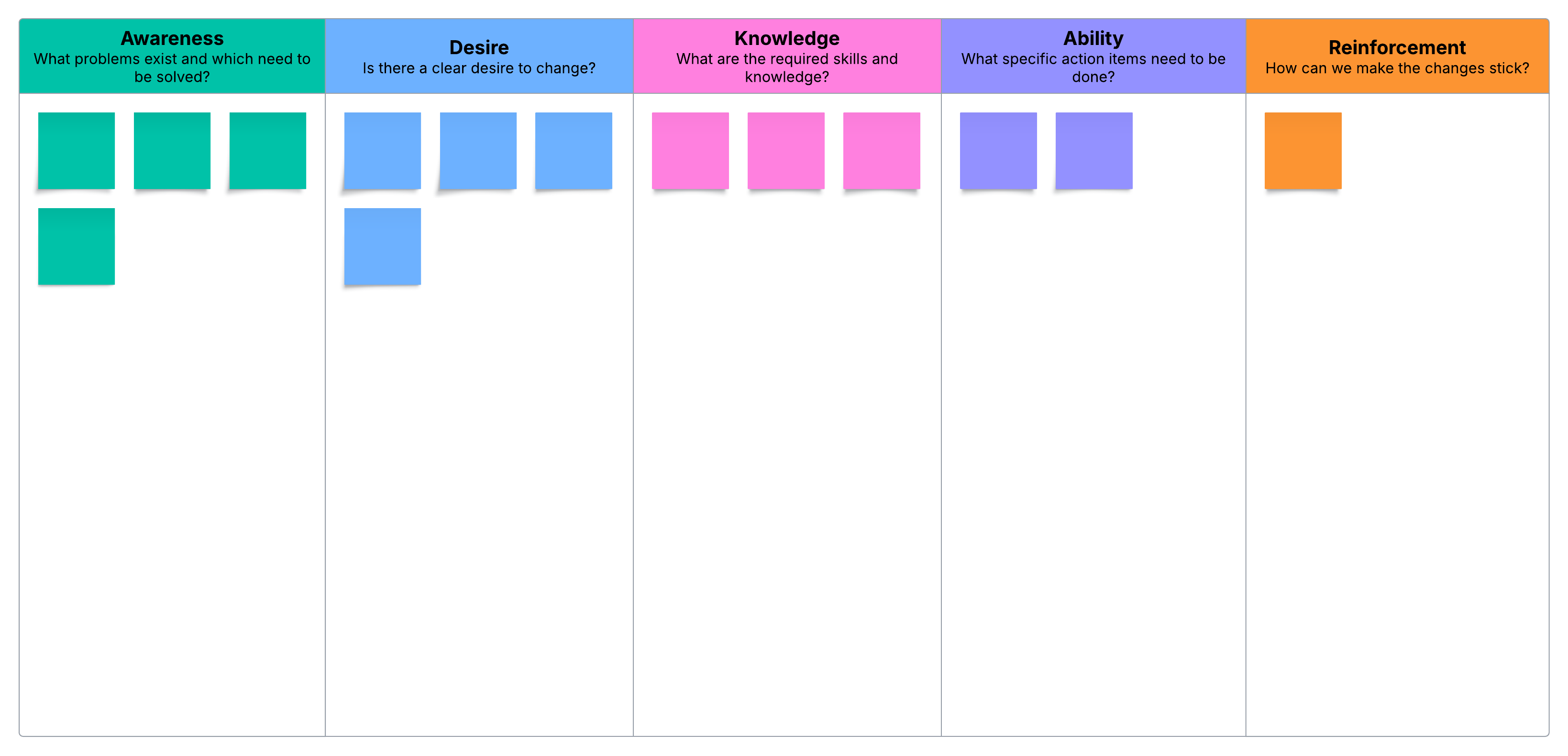
Change management 101: Strategies and examples
Reading time: about 6 min
Some businesses look to incorporate massive changes without a solid implementation plan, but the strategy behind big corporate changes often determines how successful the outcomes of those changes are. That’s where change management comes in.
Change management strategy is a critical tool for navigating changes on both minor and major scales.
What is change management strategy?
A change management strategy is a planned and systematic approach to effectively navigating organizational changes. Think of it as the engine powering change. It involves processes, techniques, and principles that support individuals, teams, and organizations in adapting and embracing change.
The primary goal of a change management strategy is to minimize resistance and disruption associated with changes and maximize the chances of successful implementation. It helps organizations realize the intended benefits of a change initiative while mitigating any negative impacts on employees, productivity, and overall performance.
When does a company need change management strategies?
A company may need a change management strategy when it undergoes significant changes that impact its people, processes, or systems. Here are some common scenarios where change management tactics areoften necessary.
Organizational restructuring
When a company goes through mergers, acquisitions, or major reorganizations, it typically involves significant changes to reporting lines, roles and responsibilities, and overall organizational structure. A strategy for change management helps employees adapt to new working methods and minimize disruptions.
Technology implementations
Implementing new technologies or upgrading existing systems often requires changes in workflows, tools, and skill sets. A change management process ensures that employees understand the benefits of the new technology, receive proper training, and are supported during the transition to minimize resistance and maximize adoption.
AI can be a particular challenge for organizations. In fact, according to our recent survey, over a quarter of workers are hesitant to adopt AI because they prefer traditional methods and tools. But since AI offers unique opportunities to boost productivity, save money, and enhnace communication, its implementation in your org could be significant for your bottom line. Approaching its adoption intentionally with a change management strategy can make all the difference.
Process improvements
When organizations undertake process improvement initiatives, a change management strategy helps employees embrace new processes, understand their roles, and overcome resistance to change. If leaders approach process improvement with too narrow of a lens, they won’t be able to effectively identify and address blockers throughout the change.
Cultural transformation
Companies seeking to shift their culture or values, foster innovation, or enhance employee engagement may require a change management process. For example, two-thirds of companies pursuing agile transformation aren’t doing so strategically enough to yield actual results. Shifting the culture of your org, such as the shift to agile values, involves aligning behaviors, promoting new mindsets, and creating a supportive environment for the desired cultural changes.

Transform your org with our best tips for effective Agile change management.
Learn moreStrategic initiatives
When organizations embark on strategic initiatives such as entering new markets, diversifying product offerings, or pursuing sustainability goals, a change management strategy helps employees understand the strategic direction and align their efforts accordingly.
Leadership transitions
Leadership changes, particularly at the senior executive level, can create significant shifts in organizational direction, priorities, and culture. A change management process assists in effectively managing the transition, addressing any resistance or uncertainties, and ensuring continuity during leadership changes.
External market forces
Companies may need a change management strategy when faced with external market forces such as economic downturns, regulatory changes, or industry disruptions. This strategy helps organizations adapt to new market conditions and seize opportunities while mitigating potential risks.
The shift between remote, hybrid work, and in-person work within the past decade has necessitated a significant shift in the cultures of essentially every industry. Our research has found that over half of knowledge workers struggle with balancing employee productivity due to this shift, 39% have experienced a resistance to change, and 38% report challenges staying motivated. Companies cannot thrive without a strategic change management strategy to address these concerns.

Heading back to work in person? Bring the best parts of remote work with you.
Learn moreIn general, any significant change can impact employees, their work, and the organization, so if things are changing, you’ll need a change management strategy.
Types of change management strategies
There are essentially three main types of change management strategies:
-
Transformational change
The transformational change management strategy focuses on guiding organizations through substantial and profound changes that often involve a complete shift in the organization's structure, culture, and operations. This strategy is employed when an organization needs to transform fundamentally to adapt to new market conditions, capitalize on emerging opportunities, or address significant challenges.
One notable company utilizing a transformational change strategy is IBM, which shifted focus in the 1990s from being strictly hardware-oriented to being a solutions and services provider.
-
Transitional change
The transitional change management strategy focuses on managing and facilitating smaller organizational changes. It is typically implemented when the organization undergoes incremental adjustments, improvements, or modifications that do not completely transform its core strategies, structures, or culture.
The world’s most recognized restaurant, McDonald’s, is an example of a company that’s used transitional change management techniques. Remember what the menu looked like when you were young (McSalad Shakers, anyone?), and look at it now to see how it’s changed.
-
Developmental change
The developmental change management strategy focuses on continuous learning, improvement, and growth within an organization. It involves implementing changes to enhance skills, processes, systems, and overall organizational performance.
Google provides an excellent change management strategy example. It strongly fosters a culture of continuous learning, innovation, and employee development.
Steps for a change management strategy
Though your change management process will need to be adjusted based on your specific change, here are the basic steps you’ll likely be taking:
-
Define the change: Clearly articulate the change initiative's scope, objectives, and rationale. This template can help you.
-
Conduct a change readiness assessment: Assess the organization's readiness and capacity for change. Identify areas that may require additional support or resources.
-
Develop a change management plan: Create a comprehensive plan outlining the approach, strategies, and activities to manage the change effectively. Define roles and responsibilities, timelines, and milestones. Ensure alignment with the organization's overall goals and objectives.
-
Identify and engage stakeholders: Identify all stakeholders affected by the change. Understand their concerns, motivations, and levels of influence. Develop tailored strategies for engaging and communicating with them throughout the change process.
-
Provide training and support: Identify the skills and knowledge required for individuals and teams to adapt to the change. Provide ongoing support and resources to help employees navigate the change successfully.
-
Implement the change: Execute the activities outlined in the change management plan. Monitor progress, address any issues or concerns, and make necessary adjustments.
-
Monitor and evaluate: Collect feedback from stakeholders, measure key performance indicators, and evaluate the effectiveness of the change management strategies.

Simplify change with a change management strategy
Change is necessary, and you’ll need to become comfortable with it for your organization to thrive. However, the way change is implemented often dictates its outcome. Approach change with a strategy, and you can better guide your business to success.

Ready to pick the best change management strategy for your team?
Get the guideAbout Lucid
Lucid Software is the leader in visual collaboration and work acceleration, helping teams see and build the future by turning ideas into reality. Its products include the Lucid Visual Collaboration Suite (Lucidchart and Lucidspark) and airfocus. The Lucid Visual Collaboration Suite, combined with powerful accelerators for business agility, cloud, and process transformation, empowers organizations to streamline work, foster alignment, and drive business transformation at scale. airfocus, an AI-powered product management and roadmapping platform, extends these capabilities by helping teams prioritize work, define product strategy, and align execution with business goals. The most used work acceleration platform by the Fortune 500, Lucid's solutions are trusted by more than 100 million users across enterprises worldwide, including Google, GE, and NBC Universal. Lucid partners with leaders such as Google, Atlassian, and Microsoft, and has received numerous awards for its products, growth, and workplace culture.
Related articles
3 Agile change management tips: Leading through transformation
In this blog post, we share three change management tips that leaders can champion for successful agile transformation.
5 organizational change management strategies for a modern workforce
Organizational change management is complex. Learn from Lucid’s experts on how to pull off a company-wide shift.
What is change management, and why is it a necessity for organizations today?
Uncover the most significant challenges and benefits of change management in organizations today. Get the necessary tools and templates to manage any change effectively.
3 steps to aligning executives for effective change management
Learn how to conquer change management by establishing executive alignment first in this guest blog post by ExperiencePoint.
